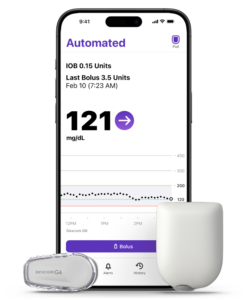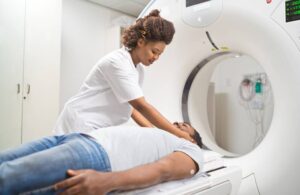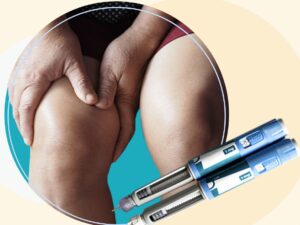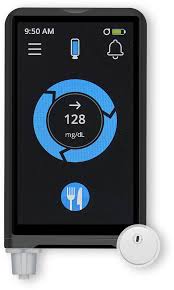In this week’s issue of The Savvy Diabetic:
-
Omnipod 5 & the iPhone App
-
Abbott CGM Sensors OK in MRI
-
FDA Rejects Sotagliflozin for T1D
-
Chinese Stem Cell-Based Therapies
-
Semaglutide for Knee Osteoarthritis Pain
-
Beta Bionics Launches iLet with Abbott FreeStyle Libre 3 Plus
-
AI For Diabetes with Cardiomyopathy
-
Insulcloud Cleared by FDA for Insulin Pens
-
Dexcom CCO to Retire Following Sales Restructuring
Insulet rolls out iPhone app for Omnipod 5 insulin pump in US by GlobalData.com, 31 October 2024. The app allows users to control the Omnipod 5 from the phone instead of carrying a separate controller.
 Insulet has launched the Omnipod 5 automated insulin delivery app for iPhone in the US. The app obviates the need for carrying a separate controller as it allows users to manage their insulin requirements via the app.
Insulet has launched the Omnipod 5 automated insulin delivery app for iPhone in the US. The app obviates the need for carrying a separate controller as it allows users to manage their insulin requirements via the app.
In addition to managing insulin delivery, the app also has a custom food feature that allows users “to input, save, and list carbohydrate counts for their typical meal sizes, favorite foods, and snacks”. It also has a SmartBolous calculator where users can select from a personalized list of foods to determine the amount of insulin required, which can help minimize carb counting and simplify mealtime maths, as per Insulet.
Read more; Insulet rolls out iPhone app for Omnipod 5 insulin pump in US
Abbott CGM sensors can now be worn during common imaging procedures by Michael Walter for CardioVascularBusiness.com, 30 October 2024.
 The sensors from Abbott’s FreeStyle Libre 2 and Libre 3 continuous glucose monitoring (CGM) systems can now be worn during common medical imaging procedures. This includes X-rays, CT scans and MRI scans, the company announced. This change represents a step forward for diabetes patients, who face a heightened risk of developing cardiovascular disease or other health conditions that may require medical imaging.
The sensors from Abbott’s FreeStyle Libre 2 and Libre 3 continuous glucose monitoring (CGM) systems can now be worn during common medical imaging procedures. This includes X-rays, CT scans and MRI scans, the company announced. This change represents a step forward for diabetes patients, who face a heightened risk of developing cardiovascular disease or other health conditions that may require medical imaging.
The U.S. Food and Drug Administration (FDA) made the change after reviewing extensive testing performed by imaging specialists. Once the FDA felt Abbott had sufficiently proven the Libre 2 and Libre 3 sensors were still fully functional after undergoing common imaging examinations, the agency agreed to remove the requirement that said these CGM sensors had to be removed in advance.
“For people with diabetes, especially those using insulin, removing a CGM sensor for long periods can be problematic,” Carol Wysham, MD, clinical professor of medicine at the University of Washington School of Medicine and section head of the department of diabetes and endocrinology at Rockwood Clinic in Spokane, said in a statement. “Previously, patients had to remove their sensors during these procedures, resulting in several hours without critical data, especially if they didn’t have a replacement sensor. The removal of the imaging contraindication from Abbott’s FreeStyle Libre 2 and 3 systems is a big win for patients, allowing them to keep their sensors on and avoid lost data.”
FDA panel votes against sotagliflozin for glucose control in type 1 diabetes, CKD by Erik Swain for Healio.com/endocrinology, 1 November 2024.
 The FDA’s Endocrinologic and Metabolic Drugs Advisory Committee recommended not approving sotagliflozin for glucose control as an adjunct to insulin in adults with type 1 diabetes and CKD.
The FDA’s Endocrinologic and Metabolic Drugs Advisory Committee recommended not approving sotagliflozin for glucose control as an adjunct to insulin in adults with type 1 diabetes and CKD.
In a 3-11 vote, the committee determined that the risks, especially those for diabetic ketoacidosis, did not outweigh the benefits of glucose control conferred by sotagliflozin (Zynquista, Lexicon) in this population.
 But THERE’S MORE TO IT! From Dr. Viral Shah on LinkedIn: My two cents on DKA rates: Increasing DKA in T1D may not really be due to insulin omission or suboptimal control. I believe that increasing use of cannabis is contributing to increasing DKA (called CHS). There is an urgent need to characterize CHS-related DKAs vs real DKAs. DKA due to SGLT-2 is a real risk. However, increasing DKA in the general T1D population is not related to insulin omission or A1c or SGLT use and I think the increasing use of cannabis across the US is confounding this increasing DKA prevalence. https://www.linkedin.com/posts/viral-shah-860a3138_fda-endocrinologic-and-metabolic-drugs-advisory-activity-7257855130513866754-HU3U
But THERE’S MORE TO IT! From Dr. Viral Shah on LinkedIn: My two cents on DKA rates: Increasing DKA in T1D may not really be due to insulin omission or suboptimal control. I believe that increasing use of cannabis is contributing to increasing DKA (called CHS). There is an urgent need to characterize CHS-related DKAs vs real DKAs. DKA due to SGLT-2 is a real risk. However, increasing DKA in the general T1D population is not related to insulin omission or A1c or SGLT use and I think the increasing use of cannabis across the US is confounding this increasing DKA prevalence. https://www.linkedin.com/posts/viral-shah-860a3138_fda-endocrinologic-and-metabolic-drugs-advisory-activity-7257855130513866754-HU3U
Read more: FDA panel votes against sotagliflozin for glucose control in type 1 diabetes, CKD
Curing Diabetes: Chinese Scientists in the Spotlight by Miroslava Calegari for Type1DManiac.com, 29 October 2024.
 Recently, the media was flooded with news about the first person cured of diabetes, sparking great excitement and curiosity. These reports highlighted the groundbreaking work of Chinese scientists developing stem cell-based therapies. One’s own umbilical cord blood is not necessary, as scientists can reprogram cells into pluripotent (universal) cells from any type of cells, such as skin cells.
Recently, the media was flooded with news about the first person cured of diabetes, sparking great excitement and curiosity. These reports highlighted the groundbreaking work of Chinese scientists developing stem cell-based therapies. One’s own umbilical cord blood is not necessary, as scientists can reprogram cells into pluripotent (universal) cells from any type of cells, such as skin cells.
The key difference lies in their method of reprogramming cells. While other teams, like Vertex, use genetic engineering to alter cells, the Chinese scientists use chemicals instead.
![]() Professor Deng’s career spans several prestigious institutions, including Wuhan University, Shanghai Medical College, UCLA, and NYU School of Medicine. He also served as a Research Director at ViaCell, a biotech company in Boston specializing in stem cell research. In 2000, after receiving a prestigious award from the Chinese government, Deng returned to China. He’s leading a research team at Peking University. His initial work focused on diabetes and human embryonic stem cells.
Professor Deng’s career spans several prestigious institutions, including Wuhan University, Shanghai Medical College, UCLA, and NYU School of Medicine. He also served as a Research Director at ViaCell, a biotech company in Boston specializing in stem cell research. In 2000, after receiving a prestigious award from the Chinese government, Deng returned to China. He’s leading a research team at Peking University. His initial work focused on diabetes and human embryonic stem cells.
Professor Deng’s presentation emphasized global collaboration. He continually highlighted the importance of international partnerships in advancing this research. The uniqueness of the Chinese study lies in its reprogramming system, the use of the patient’s own cells, the establishment of criteria for release and safety, which serve as a benchmark for the future, the implantation site, and the possibility of freezing the cells.
Read more: Curing Diabetes: Chinese Scientists in the Spotlight
Obesity Drug Shows Promise in Easing Knee Osteoarthritis Pain by Gina Kolata for NYTimes.com, 30 October 2024.
 The blockbuster drug semaglutide, sold as Ozempic for diabetes and as Wegovy for weight loss, now has a new proven benefit: It markedly soothed knee pain in people who are obese and have moderate to severe osteoarthritis, according to a large study. The effect was so pronounced that some arthritis experts not involved with the clinical trial were taken aback. “The magnitude of the improvement is of a scope we haven’t seen before with a drug,” said Dr. Bob Carter, deputy director of the National Institute of Arthritis and Musculoskeletal and Skin Diseases. “They had an almost 50 percent reduction in their knee pain. That’s huge.”
The blockbuster drug semaglutide, sold as Ozempic for diabetes and as Wegovy for weight loss, now has a new proven benefit: It markedly soothed knee pain in people who are obese and have moderate to severe osteoarthritis, according to a large study. The effect was so pronounced that some arthritis experts not involved with the clinical trial were taken aback. “The magnitude of the improvement is of a scope we haven’t seen before with a drug,” said Dr. Bob Carter, deputy director of the National Institute of Arthritis and Musculoskeletal and Skin Diseases. “They had an almost 50 percent reduction in their knee pain. That’s huge.”
Dr. David T. Felson, an arthritis expert and professor of medicine at Boston University School of Medicine, said the study “changes the landscape,” adding that the pain reduction is greater than anything that can be achieved short of knee replacement surgery. The results were published in the New England Journal of Medicine.
Read more: Obesity Drug Shows Promise in Easing Knee Osteoarthritis Pain
Beta Bionics launches iLet bionic pancreas with Abbott FreeStyle Libre 3 Plus by Sean Whooley for DrugDeliveryBusiness.com, 30 October 2024.
 Beta Bionics announced that it launched the integration of the iLet bionic pancreas with the Abbott FreeStyle Libre 3 Plus. The companies announced their plan to combine the FreeStyle Libre 3 Plus continuous glucose monitor (CGM) with iLet last month. According to Beta Bionics, this makes iLet the first available automated insulin delivery (AID) system to integrate with Libre 3 Plus in the U.S.
Beta Bionics announced that it launched the integration of the iLet bionic pancreas with the Abbott FreeStyle Libre 3 Plus. The companies announced their plan to combine the FreeStyle Libre 3 Plus continuous glucose monitor (CGM) with iLet last month. According to Beta Bionics, this makes iLet the first available automated insulin delivery (AID) system to integrate with Libre 3 Plus in the U.S.
Beta Bionics iLet system received FDA clearance in May 2023. iLet users can “go bionic,” requiring no carb counting or insulin correction calculations. Then, iLet determines 100% of the insulin doses throughout the day. The only input required to get started is the user’s weight.
Abbott’s FreeStyle Libre 3 Plus is the company’s latest-generation CGM designed for insulin pump integration. Its readings every minute can help iLet calculate insulin doses.
Read more: Beta Bionics launches iLet bionic pancreas with Abbott FreeStyle Libre 3 Plus
AI Can Help ID Patients With Diabetes at Highest Risk for Cardiomyopathy by Lori Solomon for HealthDay.com, 30 October 2024.
 Machine learning can help identify individuals with diabetes at high risk for diabetic cardiomyopathy (DbCM), according to a study published in the European Journal of Heart Failure.
Machine learning can help identify individuals with diabetes at high risk for diabetic cardiomyopathy (DbCM), according to a study published in the European Journal of Heart Failure.
Matthew W. Segar, M.D., from the Texas Heart Institute in Houston, and colleagues developed and validated a machine learning-based clustering approach to identify high-risk DbCM based on echocardiographic and cardiac biomarker parameters. The training model included 1,199 individuals with diabetes participating in the Atherosclerosis Risk in Communities cohort who were free of cardiovascular disease. The model was validated using data from 802 participants in the Cardiovascular Health Study and a separate cohort of 5,071 electronic medical records.
Read more: AI Can Help ID Patients With Diabetes at Highest Risk for Cardiomyopathy
Insulcloud secures FDA clearance for diabetes management device by Ross Law for MedicalDevice-Network.com, 30 October 2024.
 Insulcloud has received 510(k) clearance from the US Food and Drug Administration (FDA) for Insulclock CAP, a smart monitoring device for diabetes management, and now plans to establish a presence in the US market. The Spain-based health tech’s Insulclock CAP is Bluetooth-enabled and small enough to be affixed to the end of a user’s disposable insulin pen to monitor usage in real-time and help users adhere to prescribed therapy for their diabetes management.
Insulcloud has received 510(k) clearance from the US Food and Drug Administration (FDA) for Insulclock CAP, a smart monitoring device for diabetes management, and now plans to establish a presence in the US market. The Spain-based health tech’s Insulclock CAP is Bluetooth-enabled and small enough to be affixed to the end of a user’s disposable insulin pen to monitor usage in real-time and help users adhere to prescribed therapy for their diabetes management.
Intended for use by patients with type 1 or 2 diabetes, the device, which works across insulin brands, produces visual indicators, and sounds to prompt users to administer insulin at the appropriate time. It also captures information including insulin brand, insulin dose measurement, injection date and time, and the temperature of the insulin pen at the time of injection, all of which are viewable on the device’s companion app.
Read more: Insulcloud secures FDA clearance for diabetes management device
Dexcom chief commercial officer to retire by Elise Reuter for MedTechDive.com, 25 October 2024. Teri Lawver is leaving the diabetes tech company during a challenging time, with sales slowing after a workforce restructuring.
 Dexcom Chief Commercial Officer Teri Lawver will leave the company as it grapples with challenges following a sales restructuring. Dexcom has faced two difficult quarters that have sent its stock price tumbling since the beginning of the year. In July, the company slashed its 2024 revenue forecast to a range of $4 billion to $4.05 billion. Dexcom previously forecast from $4.2 billion to $4.35 billion in sales for the year. Sayer chalked up the decline to a salesforce restructuring, fewer sales through the durable medical equipment channel and lower revenue per customer due to rebates.
Dexcom Chief Commercial Officer Teri Lawver will leave the company as it grapples with challenges following a sales restructuring. Dexcom has faced two difficult quarters that have sent its stock price tumbling since the beginning of the year. In July, the company slashed its 2024 revenue forecast to a range of $4 billion to $4.05 billion. Dexcom previously forecast from $4.2 billion to $4.35 billion in sales for the year. Sayer chalked up the decline to a salesforce restructuring, fewer sales through the durable medical equipment channel and lower revenue per customer due to rebates.
CFO Jereme Sylvain said on Thursday the company is on track to meet its revised goal, reflecting “a continued ramp in our U.S. salesforce productivity.” The company’s U.S. sales declined 2% in the quarter to $701.9 million, compared to the same period a year ago.
Read more: Dexcom chief commercial officer to retire



